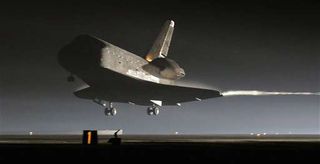Shuttle Flight's Success a Global Effort, NASA Says

CAPECANAVERAL, Fla. - The successful return of the shuttle Endeavour late Wednesdaycapped a global effort by NASA and its partners to push the International SpaceStation (ISS) another step towards completion, the U.S. agency said.
Withshuttle commander Dominic Gorie at the helm, Endeavour and its seven-astronautcrew toucheddown at NASA’s Kennedy Space Center at 8:39 p.m. EDT (0039 March 27 GMT)Wednesday after delivering a new Japanese room and two-armedCanadian robot to the $100-billion orbiting laboratory.
A Frenchastronaut, veteran European Space Agency (ESA) spaceflyer Leopold Eyharts, alsoreturned to Earth aboard the U.S. shuttle after a long-duration stay aboard theISS to commission Europe’s Columbus laboratory. But it was the mission’sJapanese payload, a storagecompartment for Japan’s school bus-sized Kibo laboratory, which rounded outthe multinational ISS partnership in space.
“It tookyears to make it happen,” NASA chief Michael Griffin said after Endeavour’s return,adding that the 16-nation partnership has been in the making for decades. “Ifyou look around, there really isn’t, any more, a U.S. human spaceflight programor a Russian human spaceflight program.
“There is aworld human spaceflight program centered around the building, and then laterthe utilization of, the International Space Station,” Griffin said. “We hope oncewe get that under our belt, that we’ll go on to the moon and then to Mars.”
Just beforeEndeavour landed, the ISS and Europe’s firstunmanned cargo ship Jules Verne passed over the shuttle’s runway. The cargotug, the first of up to seven ESA Automated Transfer Vehicles, is on a shakedowncruise and is set to make a pair of test approaches at the station over thenext week for a planned April 3rd docking.
“I can’tthink of a better day, or ending of a day, than to see those three wonderfulpieces of hardware,” said Bill Gerstenmaier, NASA’s associate administrator forspace operations.
Get the Space.com Newsletter
Breaking space news, the latest updates on rocket launches, skywatching events and more!
NASA plansto launch 10 more shuttle flights between now and 2010 to complete spacestation construction before the agency retires its aging, three-orbiter fleet.One side trip, a planned August flight to overhaul the Hubble Space Telescope,is also on the books.
Gerstenmaiersaid that the process of incorporating safety modifications developed after the2003 Columbia tragedy into brand new shuttle fuel tanks could prompt someschedule slips for upcoming flights. But any changes should not impact theoverall station assembly plan by 2010, he added.
“It looks fairlydecent on paper even if we do have some delays on the way,” Gerstenmaier said.
In lateMay, NASA’s shuttle Discovery is slated to launch the massive primary modulefor Japan’s Kibo lab, though the mission will likely fly a few days later thanits initial May 25th target due to delays with its external fuel tank, the agencysaid.
“It’s afirst step for our Kibo construction,” said Kaoru Mamiya, vice president of theJapan Aerospace Exploration Agency (JAXA), which built the station’s Kibo lab. “Wehope, the next time, the main module will be added to the station.”
Mamiya saidhe looks forward to continued cooperation with NASA and other ISS partnersbeyond the station program.
- NEW VIDEO: STS-123 Rewind: Launch to First Spacewalk
- NEW VIDEO: STS-123 Rewind: The Rise of Station's Dextre Robot
- VIDEO: Japan's First Space Station Module
Join our Space Forums to keep talking space on the latest missions, night sky and more! And if you have a news tip, correction or comment, let us know at: community@space.com.

Tariq is the Editor-in-Chief of Space.com and joined the team in 2001, first as an intern and staff writer, and later as an editor. He covers human spaceflight, exploration and space science, as well as skywatching and entertainment. He became Space.com's Managing Editor in 2009 and Editor-in-Chief in 2019. Before joining Space.com, Tariq was a staff reporter for The Los Angeles Times covering education and city beats in La Habra, Fullerton and Huntington Beach. In October 2022, Tariq received the Harry Kolcum Award for excellence in space reporting from the National Space Club Florida Committee. He is also an Eagle Scout (yes, he has the Space Exploration merit badge) and went to Space Camp four times as a kid and a fifth time as an adult. He has journalism degrees from the University of Southern California and New York University. You can find Tariq at Space.com and as the co-host to the This Week In Space podcast with space historian Rod Pyle on the TWiT network. To see his latest project, you can follow Tariq on Twitter @tariqjmalik.
